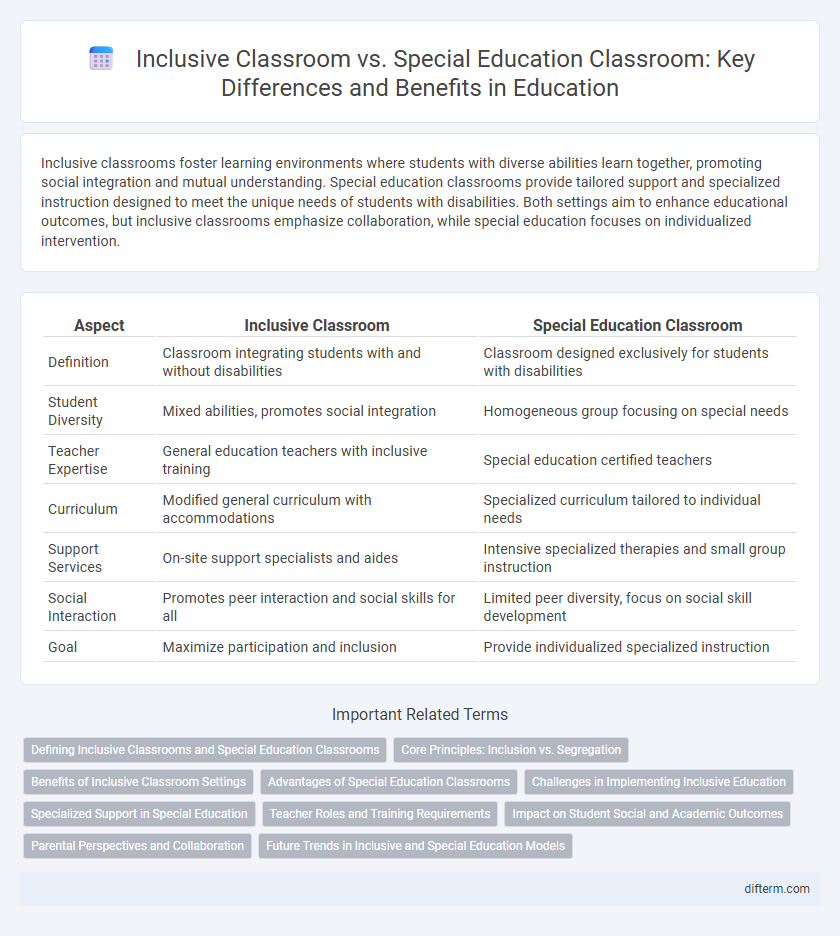Inclusive classrooms foster learning environments where students with diverse abilities learn together, promoting social integration and mutual understanding. Special education classrooms provide tailored support and specialized instruction designed to meet the unique needs of students with disabilities. Both settings aim to enhance educational outcomes, but inclusive classrooms emphasize collaboration, while special education focuses on individualized intervention.
Table of Comparison
| Aspect | Inclusive Classroom | Special Education Classroom |
|---|---|---|
| Definition | Classroom integrating students with and without disabilities | Classroom designed exclusively for students with disabilities |
| Student Diversity | Mixed abilities, promotes social integration | Homogeneous group focusing on special needs |
| Teacher Expertise | General education teachers with inclusive training | Special education certified teachers |
| Curriculum | Modified general curriculum with accommodations | Specialized curriculum tailored to individual needs |
| Support Services | On-site support specialists and aides | Intensive specialized therapies and small group instruction |
| Social Interaction | Promotes peer interaction and social skills for all | Limited peer diversity, focus on social skill development |
| Goal | Maximize participation and inclusion | Provide individualized specialized instruction |
Defining Inclusive Classrooms and Special Education Classrooms
Inclusive classrooms integrate students with diverse learning abilities and backgrounds, fostering collaboration and equal access to general education curricula. Special education classrooms provide tailored instruction and specialized support to students with identified disabilities, emphasizing individualized education plans (IEPs). Both settings aim to enhance student outcomes, but inclusive classrooms promote interaction within a mainstream environment while special education classrooms focus on targeted interventions.
Core Principles: Inclusion vs. Segregation
Inclusive classrooms emphasize collaboration and diversity, integrating students with varying abilities into a shared learning environment to promote social interaction and equal access to educational opportunities. Special education classrooms often utilize segregation to provide specialized instruction tailored to individual needs, focusing on targeted interventions and support. Core principles of inclusion prioritize accessibility and community engagement, while segregation centers on individualized adaptations within a distinct setting.
Benefits of Inclusive Classroom Settings
Inclusive classroom settings enhance social integration and peer interaction for students with diverse learning needs, fostering empathy and collaboration among all learners. They provide access to the general education curriculum, promoting higher academic achievement and reducing stigma associated with special education. Research indicates that inclusive environments improve behavioral outcomes and support the development of critical social and communication skills essential for lifelong success.
Advantages of Special Education Classrooms
Special education classrooms provide tailored teaching strategies and individualized support that address diverse learning disabilities and developmental challenges, fostering an environment optimized for student success. The specialized resources and trained educators enhance skill acquisition and behavioral development, promoting higher academic achievement and social integration. These classrooms enable personalized pacing and targeted interventions, which are often unfeasible in inclusive settings with broader student needs.
Challenges in Implementing Inclusive Education
Implementing inclusive education faces challenges such as insufficient teacher training in differentiated instruction and adaptive technologies, which are essential for addressing diverse learning needs within one classroom. Schools often grapple with limited resources and inadequate support services for students with disabilities, hindering the effective integration of individualized education plans (IEPs) in inclusive settings. Balancing curriculum accessibility while maintaining academic standards remains difficult, impacting both student engagement and overall classroom dynamics.
Specialized Support in Special Education
Special education classrooms provide specialized support tailored to students with specific learning disabilities, offering individualized instruction and adaptive resources that address unique educational needs. These environments utilize specialized staff, including special education teachers, speech therapists, and occupational therapists, to enhance learning outcomes through targeted interventions. In contrast, inclusive classrooms integrate students with disabilities into general education settings, promoting social interaction but often lacking the intense, specialized resources available in dedicated special education settings.
Teacher Roles and Training Requirements
Teachers in inclusive classrooms must be adept at differentiating instruction and managing diverse learning needs, requiring training in universal design for learning and collaborative teaching strategies. Special education teachers receive specialized training in individualized education programs (IEPs), behavioral interventions, and disability-specific instructional methods to support students with unique learning challenges. Both roles demand ongoing professional development to effectively address student diversity and promote equitable learning outcomes.
Impact on Student Social and Academic Outcomes
Inclusive classrooms promote diverse social interactions and enhance peer relationships, leading to improved social skills and empathy among students. Research indicates that students in inclusive settings often demonstrate higher academic achievement and greater motivation compared to those in special education classrooms. Special education environments provide tailored support but may limit opportunities for social integration and peer learning, impacting overall social development.
Parental Perspectives and Collaboration
Parents often emphasize the benefits of inclusive classrooms for promoting social interaction and peer learning among students with and without disabilities. Many advocate for collaborative efforts between general and special education teachers to address diverse learning needs effectively. Consistent communication and involvement of parents in decision-making processes enhance trust and ensure tailored educational support for their children.
Future Trends in Inclusive and Special Education Models
Future trends in inclusive education emphasize personalized learning technologies and universal design for learning (UDL) to support diverse student needs within general classrooms. Special education models are increasingly integrating assistive technologies and data-driven interventions to provide targeted support while promoting student autonomy. Collaboration between educators, families, and specialists is expected to deepen, enhancing adaptive curricular approaches and fostering equitable access to educational resources.
inclusive classroom vs special education classroom Infographic

 difterm.com
difterm.com